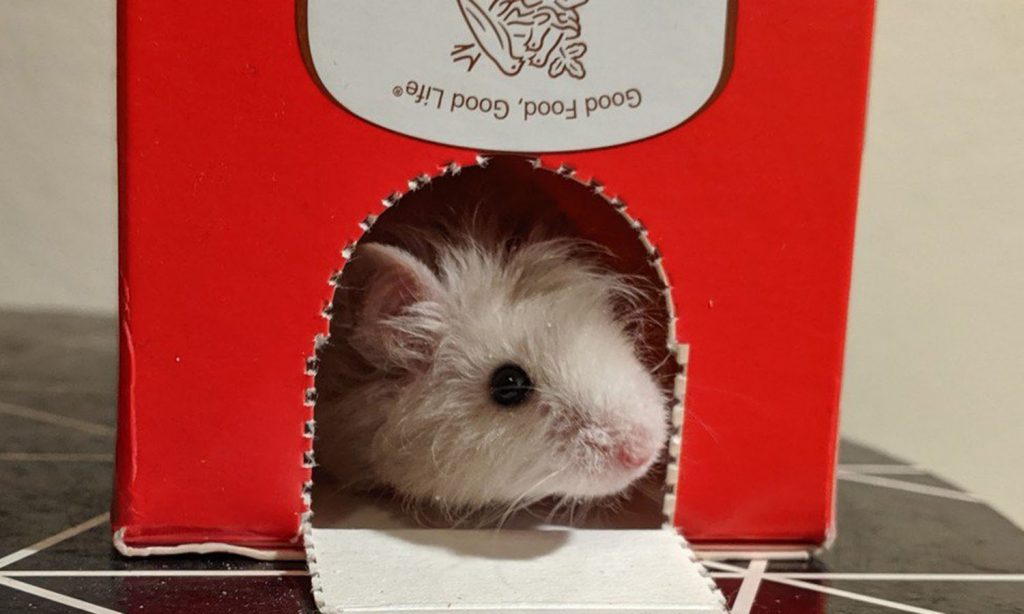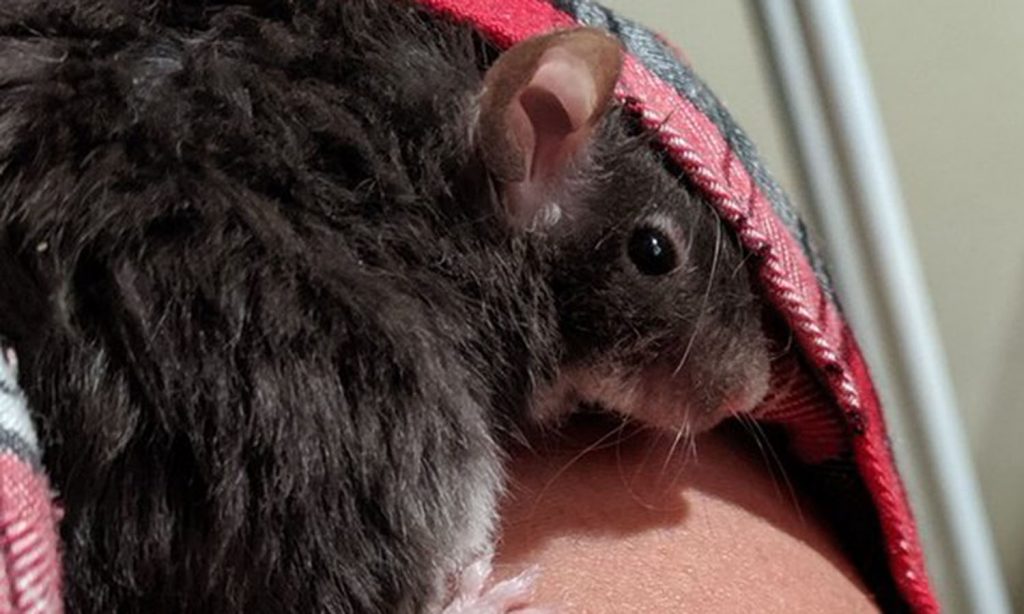Their Little Lives
Dora died on a Monday night. Her limp white body felt smaller, lighter, than the square of paper towel we used as a shroud. We buried her in a Leggo’s tomato paste box in the front yard just as it began to rain. My partner, a 50-year-old man, cried as I piled the earth back over the hole. “She’s just a mouse… why do I feel so sad?”
As a pet mouse, Isadorable ‘Dora’ Cu Chi Coo was not expected to live a long life. The average pet mouse lives 18-30 months in good health and Dora was not well in the closing days of hers. Triply named after her cuteness, willingness to explore (à la Dora the Explorer) and a love of tunnels (Cu Chi in Vietnam), Dora embodied everything that was endearing about pet mice. She was not as bolshie as her cagemate Marlene ‘Peaches’ Dietratte, whose entire purpose in life was to hide from humans forever and, if she did get caught, to bite the hand that fed her. She was not as demure as Wilde, whose pensive demeanour reminded us of an aphorism by her namesake Oscar: “We are all in the gutter, but some of us are looking at the stars.” She was sweet, loved being handled, and performed her duties as a cagemate well. And at nine months, died too young.

The first death is the deepest
The other two passed under the care of a mouse-sitter a year later while we were on holiday. The day after we returned home, I picked up their bodies and shed some tears with the sitter. Later, I wrapped them in an old cloth and buried them together in the front yard near to Dora’s grave. For some reason their passing didn’t impact me as much as Dora’s. Was it because Dora was my favourite and her death had been the hardest blow? Or had the first death primed me for the following ones?
People often think of mice as pets for children. They are easy to look after, good for smaller homes and teach kids about pet responsibility. But inevitably, their little lives mean children will need to face their deaths.
Death of a pet is often used as a teachable moment. It is commonly the first death a child will experience, and the manner in which parents handle the process of communicating the death, treating the dead animal and managing grief becomes a model for how the child might handle later encounters with death. This will also reflect the family’s values: religious parents may talk about how the pet has gone to God; avoidant parents might talk about the animal going to ‘the farm’ or ‘the forest’. Very young children find it very hard to understand death’s permanence, so it is crucial for them to understand that their pet will never wake up, or that an absent pet will never return.
Relationships also matter. I cried more about Dora than I did when either of my grandmothers died (one grandfather had passed before I was born, the other when I was too young to know him). Maybe it was because she was my colleague as I spent late nights at the computer so I felt a bond that I did not share with my grandmothers, who lived in another country, to whom I barely spoke. Perhaps it is because both grandmothers had lived full lives, they were old and their times had come, whereas Dora was barely halfway through an already short lifespan. Or it could have been that, as Dora’s caregiver, I may have been able to do more to save her compared to my grandmothers, who died in a foreign land.
About a month after we buried Peaches and Wilde I bought two boys, fuzzy Rex mice we called Arthur and Gustav after our favourite kings, one fictional, the other Swedish. Parenting guides are split on this practice. On one hand, having a new pet – especially with a different personality to the former one – can help with the grieving process. It takes the focus off the sadness of loss and reminds kids of the joy of having a pet again. On the other, parents need to avoid sending the message that an individual pet is replaceable.

As adults, we understood Arthur and Gustav would never be like Dora, Peaches and Wilde. While Arthur was timid and loved to be petted, Gustav spent the entirety of his time asserting his dominance over both his brother and his hapless human handlers. The military spirit of Gustavus Adolphus reigned within.
We had them a year before we holidayed again. An acquaintance who’d had mice as a boy offered to look after them. He lived closer than the mouse-sitter I’d used previously, and it was nice to know they’d be in friendly hands. I told him the story of my girls, priming him for the possibility that they might not make it through to my return and instructed him not to tell me if they passed while I was away.
Upon my return I learnt that Arthur had crossed over the rainbow bridge several days prior and had been buried in the park nearby. So it was recalcitrant Gustav I took home that day. He was in rude health considering the recent demise of his brother, but I’m guessing that if you only live for 18 months, ten days is a long time ago.
We formed an uneasy relationship. I couldn’t, of course, prove that Gustav had topped Arthur but suspected him of relentless bullying that probably contributed.
When he started hiccoughing, a sign of respiratory issues, he was 17 months old – one month shy of the line where I’d issue only palliative care. I took him to the vet.
One thing you don’t realise about vet waiting rooms until you walk in with a mouse is that it is full of animals much, much larger than yours, many of which are predators – not just watchful cats but adorable Yorkshire terriers and otherwise friendly rats. I was relieved when a vet called us in. I paid $200 for the privilege of her small pets expertise and a few millilitres of broad range antibiotics to be administered via mouth. I was also to buy a tin of Ensure, a nutritional supplement, and feed him manually because he would lose his appetite on the drugs.
Drugging and feeding a sick mouse who resents you is a thankless task. Because they are small, it’s difficult to hold them in a way that is both comfortable for them but allows you to force things they don’t want to consume down their throats. The only way to constrain them safely is to wrap them like a burrito in a hankie so they stop scrabbling. Eventually Gustav resigned himself to my ministrations and somehow, in my thrice daily care for him, I grew to love him.

About three months after he recovered, he relapsed. He started wheezing and losing weight so I defrosted the remaining Ensure and made enquiries of my pet-owning friends about drugs I could siphon to give him another fighting chance, although he had officially entered the palliative-care-only period. It was because of this close attention that I saw he’d developed bumps on his paws. They were not advanced enough to cause him to limp, but I suspected bumblefoot, a bacterial infection. I decided to disinfect his feet, so placed him gently in a takeaway container with a shallow pool of warm saltwater. As I dried his paws with a cloth, he drew his last breath, eyes still bright in the diffuse sun reflecting off the bathroom tiles. Did I drown him by accident? Did his lungs finally give out? Or was it multiple conditions ganging up to issue the final blow?
Gustav was not my favourite mouse, but his death hit me unexpectedly hard. I had been so involved in the last months of his life – we had grown strangely close to one another – that I seemed to take it more personally than any of the others.
I buried him in the front yard wrapped like a burrito in the cloth I’d been using as a towel. Within earshot, a real estate agent was showing a neighbouring apartment to prospective tenants. I didn’t care if they saw me dig the grave. I’ve never known a funeral to stop for a flat inspection.
This essay was shortlisted for the New Philosopher Writers’ Award, themed ‘Death’.
*****
P.S: At the time of writing, I have two new Rex boys, Olaf (a Manx named after a former king from the Isle of Man)…

…and Nero, who is quite a mild-mannered mouse considering he is named after the tyrannical Roman Emperor. Nero once cured himself of necrosis of the tail by chewing off the diseased bits.

They are brothers and lived together for a while until Olaf insisted on picking fights, despite the fact that Nero is 15g bigger. They are now neighbours.



